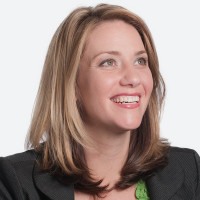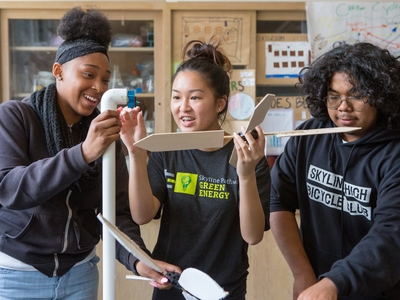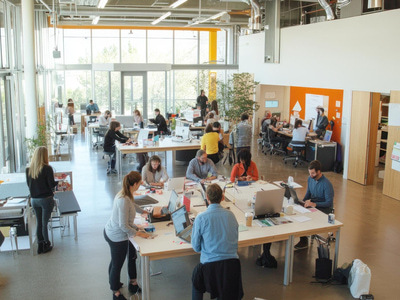New Designs for School
It’s About Self-Directed Learning
Topics
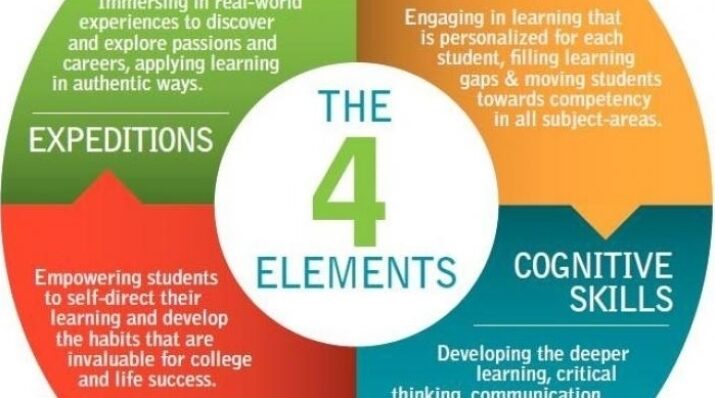
We’ve all had the experience of truly purposeful, authentic learning and know how valuable it is. Educators are taking the best of what we know about learning, student support, effective instruction, and interpersonal skill-building to completely reimagine schools so that students experience that kind of purposeful learning all day, every day.
Students in Summit Public Schools “Optimized Learning” model learn how to direct their own learning and are supported in their efforts. Diane Tavenner explains what this looks like.
Three weeks into the school year, a student in our Optimized Learning math pilot raised his hand and said to a teacher,
“I think I am behind.”
That simple statement led to a larger conversation and a good look at this ninth grader’s schooling history. When digging into his past, it became evident he had always been behind. And yet, he just kept moving forward through social promotion and low D grades. For the first time, we were asking him to be accountable for his own learning and drive his success. For the first time he wasn’t sitting in a classroom where the curriculum was moving forward even though he wasn’t learning it, and for the first time it occurred to him that he wasn’t making progress.
It was a defining moment for both this student and me.
I strongly believe that if we are to achieve our mission of preparing every student to be successful in college, career and life, they need to become self-directed learners. It is beginning to happen, student by student, when they are ready and in their own way.
When we launched our Optimized math pilot in the beginning of the school year, we gave students full autonomy over their learning. Some students did exceedingly well right away; this was the type of program they had needed their entire school career.
Mostly, students struggled almost immediately. Never before had they been expected to be so accountable for their learning, nor go so far as to drive it.
Our students recognized that ‘Optimized’ was significantly different than their other classes. They liked it in theory, and I would venture to say, craved this type of personalization. They also in theory liked the ability to drive their own learning.
However, they didn’t know what to do next. Owning your own learning is a new and heavy burden for students to carry. It is an unfamiliar and a large responsibility.
Students needed a roadmap that provided for them the behaviors, skills and even structures that led them down a path towards being self-directed learners.
We have gone through several iterations of this ‘roadmap’ to find the right balance between giving students autonomy and providing scaffolded support.
Here is what we are using today in our Optimized math pilot:
1. The Learning Cycle:
When providing students full autonomy to drive their learning, it is vital that they also own the process of learning (a role that has more traditionally resided with educators) and use that as a tool to meet their learning goals. The Learning Cycle is a tool our students can use to develop short-term goals, develop a plan to achieve these goals, record and track progress toward these goals, show evidence of what they have learned, and ultimately, take an assessment and reflect on their efforts. The Learning Cycle roughly follows a Monday to Friday schedule because it is long enough to meaningfully learn and short enough to stay focused.
2. Autonomy and Support Continuum:
Just as students need personalized learning pathways, they also need personalized supports and scaffolds to help them with the process of learning. These supports must also ultimately help students become self-directed learners. To do so, we have created an Autonomy and Support Continuum that directly connects learning with successful self-directed behaviors students need to drive their success in college and career.
3. Intervention Strategies:
Connected to the Autonomy and Support Continuum, the next level of support to help students develop successful self-directed behaviors is an intervention structure. There are currently two levels of interventions, Tier 1 and Tier 2, that are available to students when they a struggling to get back on track and meet their learning goals.
Wondering what this all looks like? Here is a week in the life of a Summit student:
MONDAY: SETTING A GOAL & PLANNING
Setting a Goal: Each Monday, a student sets a primary and secondary learning goal for the week. This learning goal is connected to their personalized Math Guide. Students also sit together by their learning goals in the Intersection.
A student who has demonstrated successful self-directed behaviors (more below under Autonomy & Support Spectrum) is given the autonomy to set their learning goal. They do so by asking two questions:
- According to my math guide, what Focus areas have I passed?
- What Focus areas do I still need to pass?
For those students who are not ready to direct their own learning, a math teacher sets their learning goals and provides coaching around why that goal was selected for them. This coaching is an important part of moving students along a continuum towards self-directed learning.
Plan: Once a learning goal has been set for the week, students then develop a plan to achieve that learning goal. A learning plan details:
- The resources students will use throughout the week to learn their goal. This can include Khan videos, practice problems, sample assessments, guided questions and lecture notes. Students are encouraged to choose resources that work best for them as a learner.
- The type of work and activities students will do to most effectively utilize each resource. For example, if a student chooses a Khan video, the type of work may be to take notes and write down examples.
- The suggested time students are going to take to work through each resource. Students create a checklist for how they will most wisely use their two hour math block each day. This ensures they stay on track towards accomplishing their goal.
Again, a student either develops this learning plan on their own, if he or she has demonstrated self-directed behaviors, or develops it with the coaching of a math teacher.
TUESDAY – THURSDAY: LEARN
Students use their Learning Plan to get to work! This can include working through the resources available in a Playlist, collaborating with peers for peer-to-peer coaching, accessing the Tutoring Bar to work through a specific challenge or problem with a teacher, and lastly, participating in a workshop focused on conceptual, real-world application.
FRIDAY: SHOW WHAT YOU KNOW & REFLECT
Show What You Know: Students are encouraged to master their learning goal by Friday, setting them up to successfully set another goal for the following week.
When a student feels they are ready to demonstrate their knowledge on a learning goal, they can take an assessment. This can happen any time during the week, but we do encourage all students to take an assessment on their learning goal by the end of each week.
All assessments are accessible on-demand through our online student portal (Illuminate). Students receive immediate feedback on their performance, if they passed or did not pass the assessment, as well as a more detailed explanation of what their strengths and weakness were on the assessment.
Reflect: A student reflects each Friday with the coaching of his or her Math Parent (a role our math team plays). We have intentionally built into the learning cycle the time to reflect on weekly progress, including students’ overall learning experience, what worked well and what can be improved and anything else that can inform a next learning goal. This includes:
- Which learning tools worked best for me?
- When did I have the ‘aha’ moment in learning?
- When did I know I was ready to take an assessment?
- If I didn’t pass my assessment, what did I do or not do?
- If I passed on a second, third or later try, what did I do differently?
SELF-DIRECTED SUPPORTS & STRUCTURES
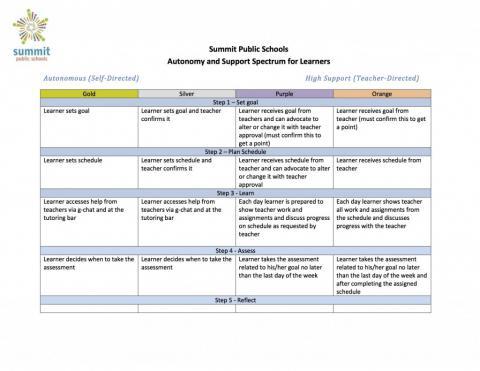
Throughout the week, and the Learning Cycle, students are receiving varying levels of autonomy and support to help them achieve their goal, what we call our Autonomy and Support Continuum.
The continuum contains levels of supports that students move through as they learn and demonstrate successful self-direct behaviors.
It starts with students who need to be highly-supported through their learning and ends with students who are autonomous, self-directed learners. Students move in real-time along this continuum.
The levels of support are broken into color bands—Orange, Purple, Silver and Gold—that include criteria for how students are supported in each color band. A students color band is connected to points they earn (or negative points) as they both move through the Learning Cycle and demonstrate observable successful (or unsuccessful) behaviors. We are using Kickboard to track the points.
Students earn points for:
- Demonstrating responsibility by taking attendance each day
- Setting a learning goal and confirming it with their math teacher
- Developing a learning plan
- Asking specific content-related questions at the tutoring bar
- Passing an assessment on a learning goal each week, or passing an additional assessment beyond their weekly learning goal
- Completing their reflection at the end of the week
- Exuding behaviors that contribute positively to the learning environment
- Working with peers
SELF-DIRECTED INTERVENTION STRATEGIES
To help students develop successful self-directed behaviors, there are additional interventions in place connected to the Autonomy and Support Continuum. There are two levels of intervention, Tier 1 and Tier 2. Both Tier 1 and Tier 2 Intervention Specialists share the same online data system and are working together at all times to gauge which students need additional coaching and support.
This first level of intervention is for students who struggle the most with self-directed learning. Each day, our Tier 1 Intervention Specialist checks in with a student by asking:
- Where are you on your learning plan?
- What is the evidence of your work?
- What decisions have you made that have helped you?
- What do you need to do next?
If the student does not show evidence that he or she is working through the learning plan, is on track to pass an assessment, or is following the initial recommendations of the Tier 1 Specialist, the student is escalated to our Tier 2 Intervention Specialist.
This teacher provides targeted content support and on-the-spot 1:1 tutoring for students who are still struggling. He or she also provides additional recommendations for how they can get back on track, which can include:
- Sending the student to the tutoring bar
- Pairing the student with a peer who can help
- Doing a 1:1 coaching session to discuss broader learning goals, what it means to truly learn a focus area and how to better make progress towards a learning goal
The Tier 2 Intervention Specialist has access to instantaneous data from the tutoring bar and the assessment room about students’ learning gaps and can analyze the trends from both to see where a large number of students are struggling.
FINAL THOUGHTS
If you read through this all, I’m impressed! It’s a lot, I know. I wanted to provide more, rather than less information. My hope is this will either spark a conversation on what more we can do to enhance our Optimized program, or help you with your own efforts in your schools.
I will leave you with this.
I am often asked if all students are self-directing their learning. The answer right now is no. We are only 16 weeks into the school year. But our students are closer than they have ever been before. In a self-directed learning model, students now have the intrinsic motivation to learn and to drive their own success. That is a step in the right direction.

